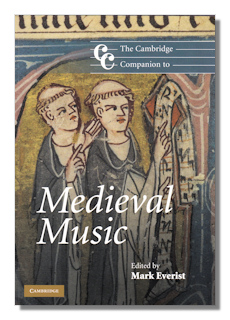
The Internet's Premier Classical Music Source
Related Links
-
Introduction
Acoustics
Ballet
Biographies
Chamber Music
Composers & Composition
Conducting
Criticism & Commentary
Discographies & CD Guides
Fiction
History
Humor
Illustrations & Photos
Instrumental
Lieder
Music Appreciation
Music Education
Music Industry
Music and the Mind
Opera
Orchestration
Reference Works
Scores
Thematic Indices
Theory & Analysis
Vocal Technique
Search Amazon
Recommended Links
Site News
 Book Review
Book Review
The Cambridge Companion to Medieval Music

Cambridge Companions to Music
Mark Everist, Editor
Cambridge University Press; 2011 1st edition, pp xxxii + 478
ISBN-10: 0521608619
ISBN-13: 978-0521608619
The Cambridge Companion to Medieval Music from CUP is a timely book, and a welcome one. It covers the period from the emergence of plainsong to the end of the fourteenth century in Europe. It's divided into three sections rather than taking a strictly chronological or narrative approach: Repertory, styles and techniques; Topography; Themes, topics and trajectories. This is a total of 19 chapters, occupying some 475 pages including notes, bibliography, and index etc. Most of the chapters are around 20 pages long. Long enough to introduce the topic, present usually tight exposition, illustrate the main aspects of the topic, and draw helpful and distilled conclusions.
The book has an excellent introduction by editor, Mark Everist, who also writes a chapter on the Thirteenth Century. The Companion is really a small but encyclopedic guide to medieval music with lots of facts embedded in simple, yet intelligent and scholarly prose expositions. It's well-illustrated with just the right amount of music examples, graphics, tables and the odd map, The Cambridge Companion to Medieval Music is an excellent starting point for anyone new to, or developing an interest in, medieval music of most sorts.
Although not based on a linear narrative, there is a spiral logic, a concentric arrangement in the book: Part I does indeed start with Plainsong, a really clean and succinct summary by Susan Boynton; it progresses through its embellishments and development to the conductus, motet and richness of early polyphony by 1200. Thence two chapters of exemplary clarity and pared-down description to the end of the period and Ars Nova and Ars Subtilior. In the course of these chapters – about 20% of the substantive text of The Cambridge Companion to Medieval Music – we are guided through topics with cross-heads, summaries and recurring consideration of performance issues, the world of manuscripts, some chronological perspective and the way that traditions (Notker, drama, liturgical etc) are to be understood.
Then, about a sixth of the book is devoted to examinations of music in England, Italy to 1300, the trecento there, in the Iberian peninsular, and east of the Rhine. Where appropriate (as in the two chapters on Italy in particular, which reflect the richness of that area) the discussion is further broken into sections according to locality. Strangely, there are no chapters on France or the Flemish and Burgundian schools.
The final part of The Cambridge Companion to Medieval Music, or over a third of the book, dissects the material thematically. The topic of music and liturgy, for instance, is expertly covered with real succinctness by Sam Barrett. Similarly, Ardis Butterfield surveys vernacular poetry and music, addressing all of the most important issues and using illustrations as appositely – as does Leofranc Holford-Strevens in the chapter that follows, on the same in Latin. In the next, longer, chapter Peter Lefferts presents a complement to Dolores Pesce's survey of Theory and Notation and looks at a representative subset of specific compositional style and practice focusing still more precisely on sacred chant and two-voice polyphony. The final four chapters in this section look at Ecclesiastical foundations, manuscripts, the reception of medieval music since the period (which Lawrence Earp divides into chant, song and polyphony); and an interesting and predictably inspiring and thought-provoking chapter by Christopher Page, "The geography of medieval music". Given that travel, journeying, pilgrimage, banishment, peregrinations and the like were so common during this period – not least to find and follow patronage – this is a fascinating area of study… the idea of the "circuits" used by musicians and the (corresponding) loci of interest and attention.
The standard of the book's production is high. Unlike some of the other volumes in the Cambridge "Companion" series, this one has a very broad sweep. Everist has done a superb job of nevertheless eliciting from his contributors depth and substance. At the same time, the material is not dense. Nor overwhelming. The Cambridge Companion to Medieval Music will also provide much for the already informed reader and music-lover. The supporting references (footnotes and chronologies, a list of manuscript abbreviations – very useful – and the bibliography) are thorough and well laid out.
Everist as editor had the difficult job of ensuring intelligent and relevant cross-references between the dozen and a half well-respected specialists. Their contributions across such a wide and rich area have made for a surprisingly unified and whole volume. One thing that will strike you almost immediately as you begin to read the book (and it is written in such a way that you can either dip in and/or work your way through sequentially) is the unassuming authority of the writing. The experts who've worked on this book are specialists with great experience and insight in all cases. But they're also able to express findings, feelings and facts with an unassuming, almost casual, yet truly dependable manner. Where an anecdote illuminates, it's included. Where it would be superfluous, it's not.
One quickly feels in good hands. The hands of these mostly British and North American contributors. One can be sure that current thinking is reflected in this book, which – inevitably – is one that deals with a rapidly-changing field. There are other such surveys available. But this comprehensive, well-conceived and written book must now rank as your first choice. Recommended.
Copyright © 2012 by Mark Sealey.


















